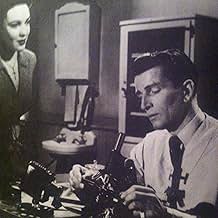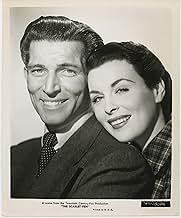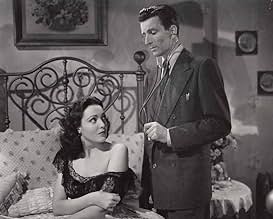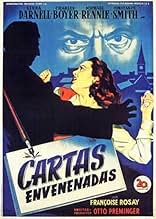AVALIAÇÃO DA IMDb
6,3/10
619
SUA AVALIAÇÃO
Adicionar um enredo no seu idiomaRespectable citizens receive anonymous letters revealing their adulterous relationships.Respectable citizens receive anonymous letters revealing their adulterous relationships.Respectable citizens receive anonymous letters revealing their adulterous relationships.
- Direção
- Roteiristas
- Artistas
George Alexander
- Dr. Fletcher
- (não creditado)
Jacques Auger
- Priest
- (não creditado)
Lucie Boitres
- Townswoman
- (não creditado)
C. Bosvier
- Townsman
- (não creditado)
Sheila M. Coonan
- Townswoman
- (não creditado)
Wilford Davidson
- Townsman
- (não creditado)
Camille Ducharme
- Fredette
- (não creditado)
J. Léo Gagnon
- Dr. Helier
- (não creditado)
Blanche Gauthier
- Townswoman
- (não creditado)
Arthur Groulx
- Townsman
- (não creditado)
- Direção
- Roteiristas
- Elenco e equipe completos
- Produção, bilheteria e muito mais no IMDbPro
Avaliações em destaque
I used to think of the Hollywood proclivity toward remaking foreign films in English to be a modern phenomenon until I encountered the 1951 remake of Fritz Lang's German classic "M" from 1939. Well, that comment segues nicely into the American remake of "Le Corbeau." "The 13th Letter" doesn't mention the French film as a source nor the historical incident from the 1920s it is based on but refers back only to the novel. It does pay some homage to its French origins. An opening title tells us that the new movie was filmed in its entirety at a "small French-Canadian community in the Province of Quebec." When I reviewed the Hollywood remake of Fritz Lang's "M" (released the same year as "The 13th Letter" but from different studios), I said that if you could, as much as possible, take the new film on its own merits then it had quite a bit to offer. I can't quite say the same for the Preminger effort. The director doesn't seem to be working too hard for a film that falls between "Where The Sidewalk Ends" and "Angel Face" in his filmography. The new film is not quite a shot-for-shot remake but is pretty much a scene-for-scene redo. The only substantial change is right at the end where a fairly long dialog passage goes to explaining the crimes in a lot more detail than Clouzot provided - but I liked the Clouzot approach better. The new young doctor is played by Michael Rennie who can't come close to showing the inner turmoil that Pierre Fresnay brought to his tormented physician. Linda Darnell is good enough as the landlord's flirty daughter if she isn't nearly as seductive and overtly sexual as the French would have it. The only real notable performance is by Charles Boyer who is quite brilliant as the elderly doctor with the young wife who the anonymous letters continually link to Rennie's character. Howard Koch wrote the screenplay. The cinematographer was Joseph LaShelle (Laura, The Apartment, Marty), so there was talent behind the camera. I can neither recommend or not recommend this picture. See it if curiosity leads you that way. It's not really a bad movie but not a very good one either.
Otto Preminger directs "The 13th Letter" from 1951, a remake of the Cluzot film, "Le Corbeau."
This dark and heavily atmospheric film takes place in a small town in Quebec. Doctor Pearson (Michael Rennie) has left a big practice after his wife left him and subsequently committed suicide. Tall and handsome, he is attracting a lot of attention, some from a woman (Linda Darnell) he considers to be a hypochondriac vying for his attention. He has been receiving anonymous poison pen letters, as have others in the town.
The wife (Constance Smith) of Dr. Laurent (Charles Boyer) has received a letter accusing her of having an affair with Pearson. A letter sent to a hospitalized war hero states he has cancer and is just not being told. This causes the man to commit suicide.
Dr. Laurent takes charge of looking for the culprit - and there are many suspects.
Good, solid film with Rennie giving a wonderful performance as a good man trying to move on after a tragedy. Boyer is energetic as Dr. Laurent, an older man married to a beautiful younger woman who doesn't want to lose her. Linda Darnell is beautiful and sultry, on her way to a second career as a femme fatale and a long way from her innocence in "The Mark of Zorro".
Constance Smith won a Hedy Lamarr look-alike contest but her career in films ended in ashes due to her bad attitude and inability to get along with studio heads. At one point, she was imprisoned for stabbing her then-boyfriend, Paul Rotha, whom she later married and stabbed again as well as making several suicide attempts. She turned to drugs and alcohol and died after being in and out of hospitals and occasionally working as a cleaner.
Good film which takes you into the story and keeps you there, wondering about the identity of the villain.
This dark and heavily atmospheric film takes place in a small town in Quebec. Doctor Pearson (Michael Rennie) has left a big practice after his wife left him and subsequently committed suicide. Tall and handsome, he is attracting a lot of attention, some from a woman (Linda Darnell) he considers to be a hypochondriac vying for his attention. He has been receiving anonymous poison pen letters, as have others in the town.
The wife (Constance Smith) of Dr. Laurent (Charles Boyer) has received a letter accusing her of having an affair with Pearson. A letter sent to a hospitalized war hero states he has cancer and is just not being told. This causes the man to commit suicide.
Dr. Laurent takes charge of looking for the culprit - and there are many suspects.
Good, solid film with Rennie giving a wonderful performance as a good man trying to move on after a tragedy. Boyer is energetic as Dr. Laurent, an older man married to a beautiful younger woman who doesn't want to lose her. Linda Darnell is beautiful and sultry, on her way to a second career as a femme fatale and a long way from her innocence in "The Mark of Zorro".
Constance Smith won a Hedy Lamarr look-alike contest but her career in films ended in ashes due to her bad attitude and inability to get along with studio heads. At one point, she was imprisoned for stabbing her then-boyfriend, Paul Rotha, whom she later married and stabbed again as well as making several suicide attempts. She turned to drugs and alcohol and died after being in and out of hospitals and occasionally working as a cleaner.
Good film which takes you into the story and keeps you there, wondering about the identity of the villain.
I thought "The 13th Letter" was a pleasant surprise, a good mystery that keeps you guessing until the end of the picture. In hindsight, it seems a good idea to place the film in Quebec - it seemed a little quirky when the film began but you gradually get used to it. Acting was good all around, especially the two old pros, Michael Rennie and Charles Boyer. Director Preminger uses all cast members as suspects and sprinkles suspicion around liberally - so much so that you can't pinpoint the culprit until late in the movie.
As noted in the site's summary, someone is writing poison pen letters to the new doctor in town (Rennie), and copying in various and sundry townspeople. The letters accuse the doctor of an affair with the wife of the head of the local hospital (Boyer). This is a well done mystery which I can't recall as being on TV. I think it would be well-received if it were dusted off by FMC - it was produced by 20th Century Fox and must be in their vaults somewhere.
As noted in the site's summary, someone is writing poison pen letters to the new doctor in town (Rennie), and copying in various and sundry townspeople. The letters accuse the doctor of an affair with the wife of the head of the local hospital (Boyer). This is a well done mystery which I can't recall as being on TV. I think it would be well-received if it were dusted off by FMC - it was produced by 20th Century Fox and must be in their vaults somewhere.
Nestled in the noir cycle is a trio of movies set in the Canadian province of Québec. Ozep's Whispering City and Hitchcock's I Confess make up the first two, followed by Otto Preminger's The 13th Letter. His strategy in setting it there was probably to preserve the Gallic ambience of the original, Clouzot's Le Corbeau (though that version is accounted more mordant and misanthropic).
Michael Rennie left a prosperous medical practice in London to set up residence in Canada after his unfaithful wife left him and later killed herself. He catches many an eye, as there are few marriageable men in the rural village, though Rennie keeps to himself and dotes on his collection of antique timepieces. But suddenly poison pen letters begin to circulate. At first they hint that Rennie is involved with the wife (Constance Smith) of a prominent doctor at the same hospital (Charles Boyer). Soon the letters take a more malicious turn, causing a young war hero to slit his throat by lying about Rennie's withholding a diagnosis of hopeless cancer. The police investigate, and the campaign of libel becomes a political cause celebre.
Rennie, meanwhile, slowly succumbs to the charms of Linda Darnell, who feigns ailments to coax him up to her rooms; beautiful but lonely, she's acutely sensitive when Rennie discovers the club foot she takes pains to conceal. She, too, falls under suspicion, along with many others as the letters continue to come....
Preminger handles the story with slow, modulated suspense, never resorting to shock tactics; his cast uniformly delivers restrained, effective performances (Rennie has never been so good). Distant thunder crackles constantly under the lowering skies, well shot by Joseph LaShelle, adding to the claustrophobic feel of provincial insularity. Yet this superior suspense film languishes in obscurity despite being one of the often dismissed Preminger's better works in the cycle, along with Fallen Angel, Where The Sidewalk Ends, Angel Face and of course Laura.
Michael Rennie left a prosperous medical practice in London to set up residence in Canada after his unfaithful wife left him and later killed herself. He catches many an eye, as there are few marriageable men in the rural village, though Rennie keeps to himself and dotes on his collection of antique timepieces. But suddenly poison pen letters begin to circulate. At first they hint that Rennie is involved with the wife (Constance Smith) of a prominent doctor at the same hospital (Charles Boyer). Soon the letters take a more malicious turn, causing a young war hero to slit his throat by lying about Rennie's withholding a diagnosis of hopeless cancer. The police investigate, and the campaign of libel becomes a political cause celebre.
Rennie, meanwhile, slowly succumbs to the charms of Linda Darnell, who feigns ailments to coax him up to her rooms; beautiful but lonely, she's acutely sensitive when Rennie discovers the club foot she takes pains to conceal. She, too, falls under suspicion, along with many others as the letters continue to come....
Preminger handles the story with slow, modulated suspense, never resorting to shock tactics; his cast uniformly delivers restrained, effective performances (Rennie has never been so good). Distant thunder crackles constantly under the lowering skies, well shot by Joseph LaShelle, adding to the claustrophobic feel of provincial insularity. Yet this superior suspense film languishes in obscurity despite being one of the often dismissed Preminger's better works in the cycle, along with Fallen Angel, Where The Sidewalk Ends, Angel Face and of course Laura.
A small Quebec town is rattled by a series of anonymous poison pen letters. Preminger takes a stab at Clouzot's LE CORBEAU (Clouzot himself being one of the finest purveyors of European noir, including LES DIABOLIQUES, THE WAGES OF FEAR and QUAI DES ORFEVRES). I don't recall the original very well, but I do know it had a more biting, cynical edge to it (as well as overt references to abortion, which of course was verboten under the Hays code) as opposed to the moodier tones found here. The subject matter is ripe for common noir themes like the fragility of civilized society and the darkness lurking beneath pleasant facades. Every performance is quite good, especially Michael Rennie and the sultry-as-ever Linda Darnell. The film keeps you guessing and keeps you interested, never playing a hand too soon. Although my copy was rather blurry, I could still appreciate the artful framing and use of light. The score is the weakest aspect, often laying on the strings too thick. Otherwise, quite a fine film.
Você sabia?
- CuriosidadesJoseph Cotten was the first actor to be approached for the role of "Dr. Pearson", and, after he had dropped out, Richard Todd was briefly considered for the role. Michael Rennie had recently had prominent supporting roles in two big Twentieth Century Fox movies made in Europe - "The Black Rose" and "The House In The Square" - and the studio was hoping to build him into a Hollywood leading man. This was his first film in America.
- ConexõesRemake of Sombra do Pavor (1943)
Principais escolhas
Faça login para avaliar e ver a lista de recomendações personalizadas
- How long is The 13th Letter?Fornecido pela Alexa
Detalhes
- Data de lançamento
- País de origem
- Idiomas
- Também conhecido como
- The 13th Letter
- Locações de filme
- St.Hilaire, Quebec, Canadá(On the Richelieu River)
- Empresa de produção
- Consulte mais créditos da empresa na IMDbPro
- Tempo de duração
- 1 h 25 min(85 min)
- Cor
- Proporção
- 1.37 : 1
Contribua para esta página
Sugerir uma alteração ou adicionar conteúdo ausente






























